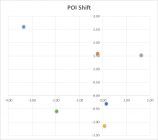Jeff Porter
Gold $$ Contributor
I do not expect bullets of different weights and velocities to impact at the same point onf the target but what I saw today may be a good example of what happens whan a barrel is not in a happy place for a bullet. These are not loads that have been worked up for this rifle, just ammo that is left form a couple of other projects.
I am playing with a new R700 SPS in .308 with a 22" 1:10 pencil barrel. I got a preliminary " zero" on the scope with the dial set to the middle of travel on both windage and elevation using the IMI RazorCore 175 SMK load at 2450 fps. It was about 1.6" high with good windage. ( Orange dot)
I then proceed to shoot five other groups with ammo from old lots I had in the ammo box ranging from 110gr to 180 gr. with Varget, 748, I-4895, H4895 and 8208.
125 TNT at 2970 fps (purple) and a 155 Palma at 2850 fps (yellow) kept windage the same but lower POI as expected for much faster loads.
110 Vmax (Gray) was the fastest load at 3300fps but it is up and right 1.5" , 110 Nosler at 3000 fps ( Green) was down and left a bit and the 180 Nosler BT (Lt. Blue) was way up and left at 2425 fps.
Not sure what it really shows but it caught my eye.
My guess is the three loads in the vertical stack in the middle are in a quieter place in the barrel vibration than the three outliers.
Any other ideas?

I am playing with a new R700 SPS in .308 with a 22" 1:10 pencil barrel. I got a preliminary " zero" on the scope with the dial set to the middle of travel on both windage and elevation using the IMI RazorCore 175 SMK load at 2450 fps. It was about 1.6" high with good windage. ( Orange dot)
I then proceed to shoot five other groups with ammo from old lots I had in the ammo box ranging from 110gr to 180 gr. with Varget, 748, I-4895, H4895 and 8208.
125 TNT at 2970 fps (purple) and a 155 Palma at 2850 fps (yellow) kept windage the same but lower POI as expected for much faster loads.
110 Vmax (Gray) was the fastest load at 3300fps but it is up and right 1.5" , 110 Nosler at 3000 fps ( Green) was down and left a bit and the 180 Nosler BT (Lt. Blue) was way up and left at 2425 fps.
Not sure what it really shows but it caught my eye.
My guess is the three loads in the vertical stack in the middle are in a quieter place in the barrel vibration than the three outliers.
Any other ideas?












